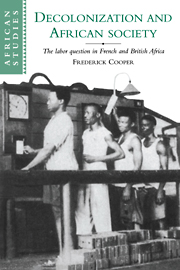Book contents
- Frontmatter
- Contents
- List of tables and figure
- Preface
- List of abbreviations
- Map of French and British colonial Africa
- 1 Introduction
- Part I The dangers of expansion and the dilemmas of reform
- Part II Imperial fantasies and colonial crises
- Part III The imagining of a working class
- Introduction
- 7 The systematic approach: the French Code du Travail
- 8 Family wages and industrial relations in British Africa
- 9 Internationalists, intellectuals, and the labor question
- Conclusion: labor and the modernizing state
- Part IV Devolving power and abdicating responsibility
- Conclusion
- Notes
- Bibliography
- Index
- OTHER BOOKS IN THE SERIES
Conclusion: labor and the modernizing state
Published online by Cambridge University Press: 22 February 2010
- Frontmatter
- Contents
- List of tables and figure
- Preface
- List of abbreviations
- Map of French and British colonial Africa
- 1 Introduction
- Part I The dangers of expansion and the dilemmas of reform
- Part II Imperial fantasies and colonial crises
- Part III The imagining of a working class
- Introduction
- 7 The systematic approach: the French Code du Travail
- 8 Family wages and industrial relations in British Africa
- 9 Internationalists, intellectuals, and the labor question
- Conclusion: labor and the modernizing state
- Part IV Devolving power and abdicating responsibility
- Conclusion
- Notes
- Bibliography
- Index
- OTHER BOOKS IN THE SERIES
Summary
The idea of stabilization, like the notion of detribalization which it displaced, was abstracted from the conditions under which workers actually lived. That urban workers in the era of stabilization policies retained rural ties – because of affective relations, because of uncertainties about urban security in ill health or old age, because of the possibilities of families combining wage labor with agriculture or petty trade to enhance collective opportunities – meant that the image of a neatly bounded world of wage labor was an unattainable one. Even had the implementation of stabilization been more thorough-going and the provisions for wages, social security, and housing more attractive, it is not clear that its cultural and social goals would have been attained.
But the power of the model was as much in its unrealistic coherence as in its concrete accomplishments. The model helped colonial officials convince themselves that they were doing more than responding to unruly Africans, even if the strikes of the 1930s and 1940s had set the rethinking of colonial policy in motion. It helped them convince skeptical colleagues first that a progressive imperialism was possible and then that progress in the directions they considered vital could continue in their absence. Trade union leaders used the model to claim entitlements for their members and positions of influence for themselves, even if they emphasized the hypocrisies of colonial rule and the shortcomings of development policy.
- Type
- Chapter
- Information
- Decolonization and African SocietyThe Labor Question in French and British Africa, pp. 383 - 386Publisher: Cambridge University PressPrint publication year: 1996

